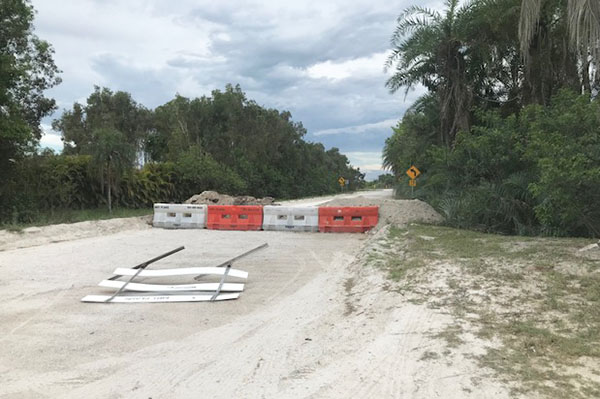
The dust has not quite settled on the issue of what Wellington should do with the unpaved southern portion of Flying Cow Ranch Road. The section was closed earlier this year and recently reopened, and options for a permanent solution could reach the Wellington Village Council in 2025.
“Why don’t we pave it?” asked Sarah Goos, a member of Wellington’s Equestrian Preserve Committee, during a meeting Wednesday, Dec. 4.
“Certainly, paving is an option,” Village Manager Jim Barnes replied.
However, he also cautioned, “If it’s a smooth ride, you’re going to have a lot more people using it.”
Feedback from residents, including equestrians, has only intensified in recent years, particularly about the haphazard, bumpy condition of the road, and the dust clouds it generates that waft toward the lungs of horses and people, Barnes said.
At the same time, worries persist that paving only invites more vehicles seeking a traffic bypass along the village’s southwestern edge.
Options are likely coming before the advisory equestrian committee, and ultimately the council, but that will not be until the spring, after the winter horse season, Barnes said. The committee did not vote on any related issues at the December meeting.
A few broad-brush outlines for major alternatives emerged after questioning. Paving the rest of Flying Cow Ranch Road could cost $4 million to $6 million, Village Engineer Jonathan Reinsvold estimated. Laying down other materials short of traditional pavement, advertised as dampening dust, have been the subject of limited experimentation and could cost up to $1 million initially, but require frequent filling of potholes and reapplications, he said.
Doing nothing, or just leaving the status quo that already involves plenty of attempted road-smoothing and upkeep, seems to be shrinking in popularity, Barnes said. “I know there are a lot of different stories floating around,” Barnes said.
He cited the occasional “conspiracy theory” on social media that the road’s closing was somehow “payback” to various local residents related to past dealings or issues with the village. He rejected that notion and said lines of communication remain as clear and open as they have ever been.
The question behind all this is what to do with the unpaved portion of Flying Cow Ranch Road, which starts four miles south of Southern Blvd. Continuing south, it takes a big left turn and connects with the southern end of the village through Indian Mound Road and 50th Street South.
Committee members wondered aloud about the seemingly sparse publicity ahead of the June closure of the southern stretch of the road, marked with road barriers and signs.
By November, officials acknowledged it had reopened, but with a 16,000-pound weight limit for trucks.
Then again, that also touches on tricky issues. The Palm Beach County Sheriff’s Office can enforce rules on truck weights or speed, but it does not have the resources to be there all the time, Barnes said.
Speeding along the upper, paved straightaway portion of Flying Cow Ranch Road has generated complaints for years, accompanied by uneasiness that trucks or other vehicles were exiting Southern Blvd. and taking Flying Cow as an informal bypass, or doing the same thing in the opposite direction.
Every proposed remedy seems to come with questions. Committee members said they were not sure if the truck weight limit actually blocked some of the equestrian industry’s own larger transport and feed vehicles, and follow-up discussion appeared to offer few definitive answers.
In the misty depths of village history, the unpaved portion of the road has been used as access to a water-pumping station and a facility that collects horse manure, but growth and traffic have put pressure on Wellington’s efforts to figure out what to do with it.
Barnes acknowledged that the village has paved some roads that were once unpaved in and around the equestrian area, such as 120th Avenue South and 50th Street South.
Committee Member Kirsten Kopp said, “My suggestion to the committee and to you is you pave it, but you put extreme measures to reduce speed.”
She mentioned steps used in places outside the village, such as limiting the whole road to one lane in some rural places. But village officials said these ideas can come with their own drawbacks, such as stalling traffic, creating confusion or abrupt braking situations.
During public comment, equestrians grappled with the pros and cons of paving.
Sloane Coles said one argument for paving the rest of Flying Cow Ranch Road, along with whatever safety measures make sense, is that it provides some option for horse trailers and other traffic from the vicinity not to have to drive by schools in the core village, for example. “It’s not ideal,” she said.
Paving did not sound so great to Maureen Brennan. “If this were to get paved, they’d just fly down 50th, through the [equestrian] preserve, fly down there, really fly up Flying Cow,” she said.
In other action, the committee discussed priorities for about $3 million in capital improvements for the village’s bridle trail system over multiple years. Advocacy for fencing along some trails, to separate horses from vehicles or canals, came up. An updated list could come before the committee in February.







